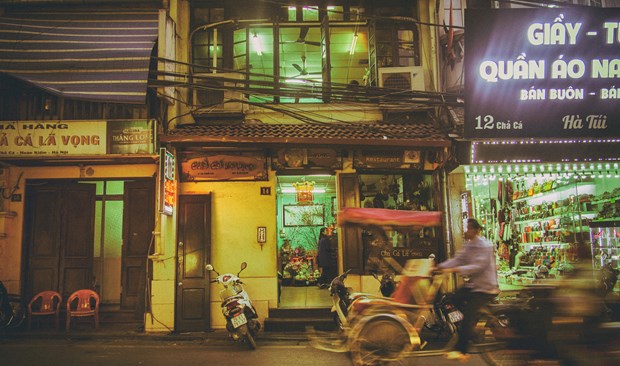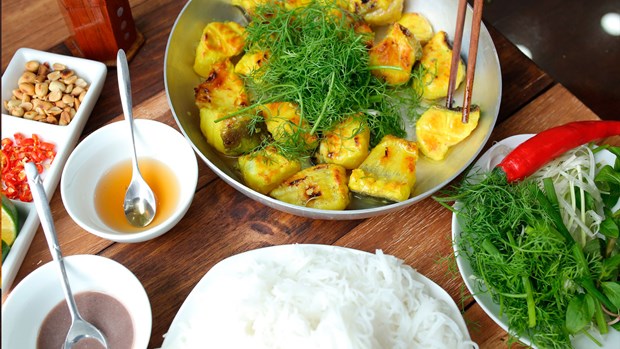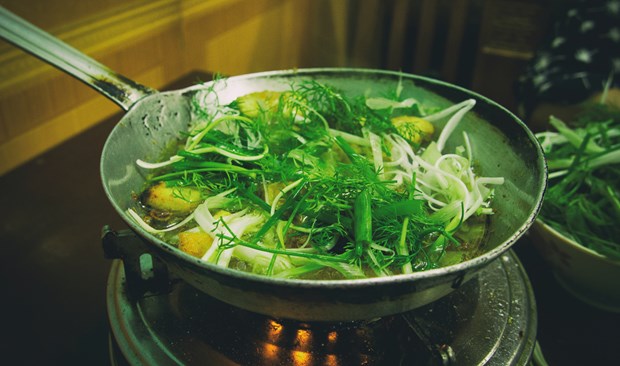In
the late 19th century, revolutionary soldiers gathered at 14 Hang Son for
clandestine meetings.
During
their quarter-century resistance against French colonialism, Doan Phuc and his
wife Bi Van welcomed the troops with pan-fried squares of fish tossed in dill,
onion, turmeric and galangal.
They
called the dish cha ca. Today, Hang
Son Street bears its name.
In
1871, the Doan family decided to conceal the rebel hideout by opening a
restaurant named after Jiang Ziya (La Vong in Vietnamese)—a Chinese noble who
made his name fishing with a bare hook and helping King Wen of Zhou overthrow
the Shang Dynasty.
Cha
Ca La Vong quickly became a hot dining spot favored by the very aristocrats and
colonial officials it sought to unseat.

Cha Ca La Vong at 14 Cha Ca Street.
During
the 1940s, Vu Bang and his wife became regulars.
In
his book Hanoi Delicacies, the future
spy recalled savoring the dish on breezy, chilly evenings with cups of the
finest rice wine—“the kind that keeps making you drink but never really gets
you drunk,” he wrote.
Bang
described the restaurant as a rowdy place he always found “dizzyingly crowded,
yet so delightful.”
Young
waiters raced through the evening, ferrying sizzling hot pans from table to
table, until the moment when one stopped, climbed onto a stool, raised a
megaphone and shouted: “Gentlemen, both cha ca and fish intestines are sold
out!”
Picturing
himself back among the cramped and cozy tables, watching smoke rise from a
skillet, Bang recalled: “Life was beautiful.”
He
defined the dish as something that could never become fast food.
"One
must be meticulous, if not picky, to enjoy cha ca at its best," he wrote.

A way to eat cha ca, as suggested by Cha Ca La Vong’s owner.
Cha
Ca La Vong managed to conceal its activities for two decades, before the French
arrested Doan Phuc and cut off his head. His wife, Bi Van, continued to run the
restaurant and passed their secret recipe to her eldest daughter-in-law.
“We
stayed, even during Operation Léa evacuation in 1947-1948,” Van’s granddaughter
Ngo Tinh, now 95 years old, told. “We sold less before the doi moi reform, but
after that business boomed.”
The
family behind Cha Ca La Vong welcomed a surge of tourists and inspired the
opening of hundreds cha ca spots throughout Hanoi and beyond.
Five
years ago, Florence Fabricant wrote a glowing feature about American cooks
trying to pay homage to the recipe for The
New York Times, but tempered her own fond recollections of eating the dish
in the restaurant Vu Bang so loved with a note of caution.
“Recent
visitors have had a more negative experience: touristy and expensive,” she
noted.
Tinh,
the fifth-generation nonagenarian fish-fryer, smiled at the mention of modern
gripes.
“We
don’t have any other way,” she said. “The fish is pricey and we don’t want to
use anything else. Nothing is as thick and tasty as bagrid catfish.”

How cha ca is served at Cha Ca La Vong.
The
meaty species remains legion for standing up to the frying pan without drying
out or falling apart.
Vu
Bang himself dismissed his wife’s cha ca
for being “always somehow crushed or overdone.”
“I’ve
heard the secret is coating the fish in dog fat, but who knows?” he told his
readers.
Tinh
vehemently dismissed Bang’s suggestion.
“It’s
no big secret,” she said. “I used to get up early, go to the market and come
home with the best fish and the freshest vegetables,” she said before pointing
to a yellowed photograph on the wall. “Look, that’s me about 20 years ago with
the biggest bagrid ever.”
Where the alcoholics
gone
Vu
Bang insisted that none of the original restaurants inspired by Cha Ca La Vong
would ever really last.
Today,
however, around 15 Hanoi restaurants specialize in the dish. Some woo customers
with cloth napkins and stemmed wine-glasses; others undercut the namesake
original by over a dollar.
On
a recent evening, the spartan dining room at Cha Ca La Vong sat nearly empty
while Cha Ca Lao Ngu on far-flung Thai Ha was already jammed.
A
fishy smoke tickled the low-ceiling as casually-dressed couples huddled
together in the chilly winter air, dipping deep-fried fish in an electric green
chili sauce and stuffing themselves on crunchy intestines before proceeding to
sweet tofu soup and daisy tea.
Old-timers
necking rice wine were nowhere to be found.
And
yet, life was still beautiful.

Crunchy fish intestines.
Writer: Quynh Trang/VnExpress